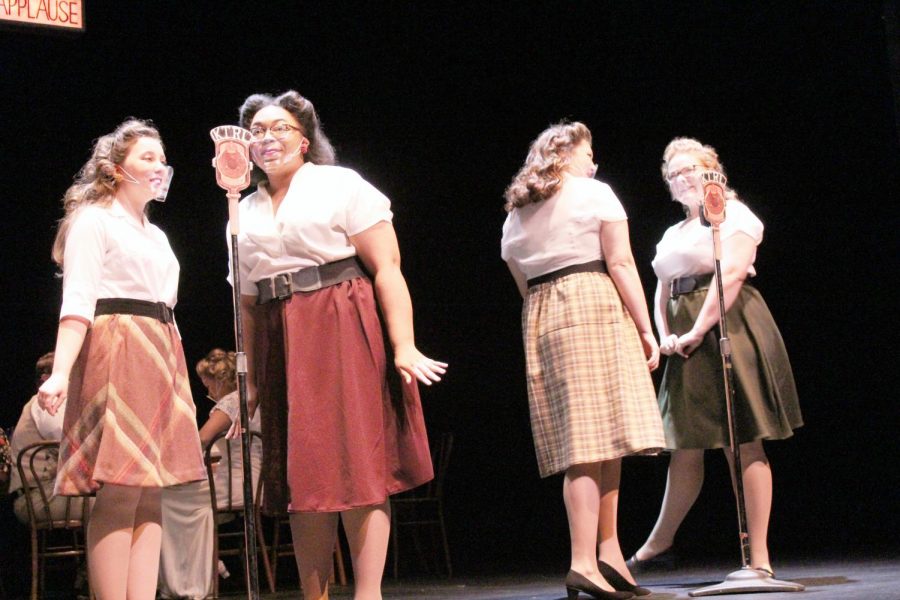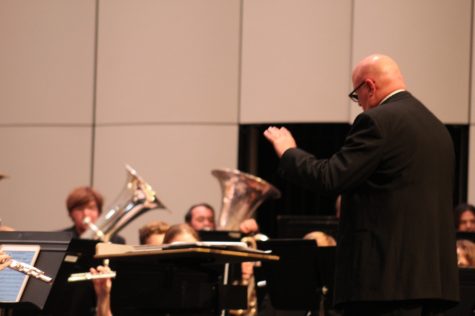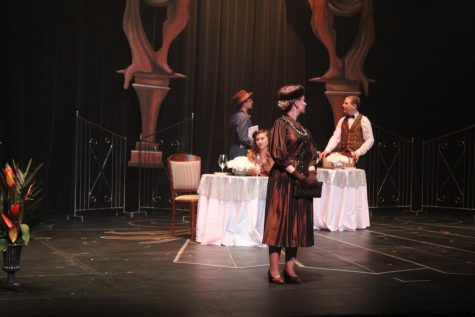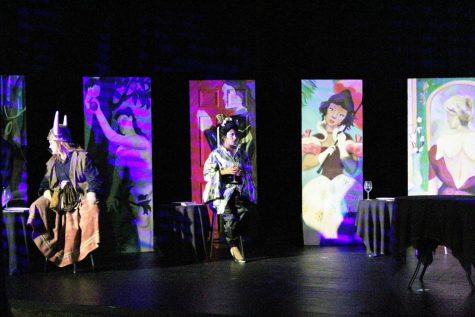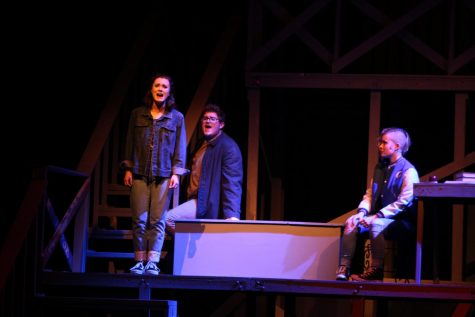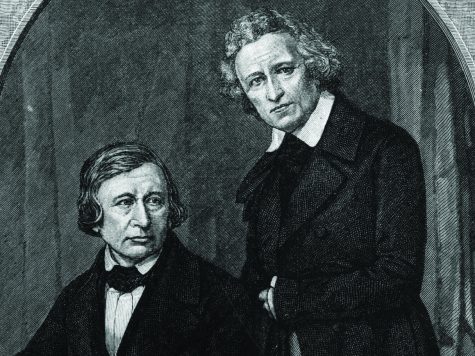Theatre at Tarleton comes to a close for the 2020 season
Theatre at Tarleton performed, “Adventures of the Thin Man: The Case of the Goofy Groom,” by Samuel Dashiell Hammett, on Nov. 10 to the 14, at 8 p.m., in the Clyde H. Wells Fine Arts Center.
The show was also broadcasted on Tarleton State University’s radio channel, KTRL 90.5 FM.
The production originally aired as a radio show in July of 1941 and ran until September of 1950.
Samuel Dashiell Hammett wrote “The Thin Man,” series of novels, which were later adapted into radio shows and films. Hammett’s novels were said to be some of the best mystery novels of the time; leading Hammett to be known as one of the best mystery writers in history. Hammett’s genre of choice seemed to be detective fiction like what one would expect from a film noir type of movie.
Hammett also wrote the “A Man Called Spade and Other Stories” series, which starred the character, Sam Spade.
Before the show began, the music playing in the theater was what you would expect from a 1940’s era mystery. It set the mood nicely and gave a hint of what was to come, although it was louder in the hallway outside than it was in the theater itself. The stage was set with two rows of microphones decorated to look like they were from the 1940’s, each row consisted of three microphones.
The first row was to the front right of the stage and the second was set to the middle left of the stage. Behind the first row of microphones was a table set with dishes and plates, and behind the second row was a door and piano. The stage was lit with a dark red light illuminating only on the microphones at first. Overall the decorations and effects gave the audience a feeling of suspense.
The show began with Nick Charles, played by Tyson Zinsmeyer, and Nora Charles, played by Laramie Gambrell, attending the wedding of Arthur, played by Cameron Bishop, and Jane, played by Yasmine Butler. As the show began I was rather disappointed when I noticed that most of the actors would hold notebooks containing their lines for the entire show.
There was also almost no blocking, otherwise known as meaningful and scripted movement, done in the show. The exception for this was when the actors would go to the table and pretend to eat after their parts were finished or return to the microphones before their parts began. Of course, changes were to be expected to fit COVID-19 guidelines. These changes included the cast wearing face shields that wrapped around their chins and covered only their noses and mouths.
The story was entertaining, as I had not seen or heard it performed before, but the plot twist was lackluster to the modern standards of M. Night Shyamalan. For the era that the show was written in, the story would have been riveting and it’s clear to see that Hammett was an excellent writer.
Theatre at Tarleton’s rendition of the show also seemed to be missing the sparkle that their performances have provided in the past. Nick Charles, played by Tyson Zinsmeyer, spoke in the same manner through the entire show and although he was not monotone, his performance seemed to give off the same effect.
Nora Charles, played by Laramie Gambrell, was the only performer of the night that I could catch looking away from the notebook in order to look at the other actors with the expressions one would expect from a theatre performance. She had the ability to look and almost completely turn to the other actors while still being clearly audible to the audience.
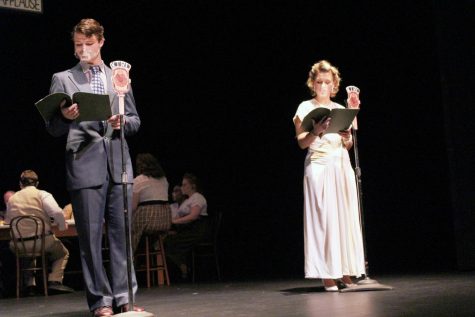
The rest of the cast gave standard performances that lacked body language or expression. This included Jane who had a few moments where she seemingly spontaneously broke into tears. There was no visual lead up to the crying and it seemed jarring to see the actress jerk forward and begin to wale into her hands only for her to stop immediately when another actor began speaking. If the cast was aiming to surprise the audience with the crying, they achieved it. It was more shocking than the gunshots Jane was supposed to be crying about. The cast also rushed during the transitions from one scene to the next. Despite this, the cast presented themselves nicely and a majority of the voice acting was well prepared.
The lighting during the show was simple. There were no noticeable effects, other than the red lighting before the show began, which was done nicely. The back of the stage was dimly lit, while the front was bright. This drew the eye to the front of the show and allowed for the movements of the actors in the back to not be distracting. The lighting allowed for the other elements of the show to stand out. The audience that chose to listen to the radio show rather than attend in person did not miss out on any lighting effects.
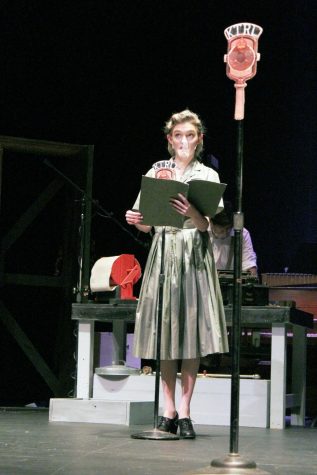
The costumes were nicely detailed and tailored to the era of the show. The female cast members wore modest dresses that reached below the knee and petite heels with simple accents. The actresses also wore hairstyles fitting to the time. The male cast members wore suits or slacks and nice shirts with simple dress shoes. They also all had shorter hair styles that were nicely maintained. My favorite costume was that of Bingo, played by Laine Williams. The dress was a simple army green that had basic pockets and belts and the shoes were black with a gold buckle. It was the kind of vintage outfit that is still wearable and flattering today.
The sound effects were what the show relied on the most to be successful and it worked. Almost all of the audio cues were on time with only one mishap. The sound effects were done by recording and in real time. The door, as mentioned before, was used for all of the audio cues when a character was entering or exiting a room. The blend of recorded and in person audio effects worked nicely in the show to achieve the 1940’s era production feel.
The set design was not what I expected at first glance. The table was not the main focus of the show, but instead a background piece to keep the actors on stage even when it was not their part. I enjoyed this as it is something that I have not seen in many productions and it was done well with the lighting to prevent the audience from getting distracted. The same goes for the piano and the door, but because the door was used in real time it added to the show.
In conclusion, Theatre at Tarleton’s rendition of “Adventures of the Thin Man: The Case of the Goofy Groom,” is well worth the 30 minute watch. I enjoyed being able to go to an actual show and the minor flaws did not take away from the overall enjoyment of the production. I am excited to see what Theatre at Tarleton puts on next semester and would suggest taking the time to go see one of their future productions.



